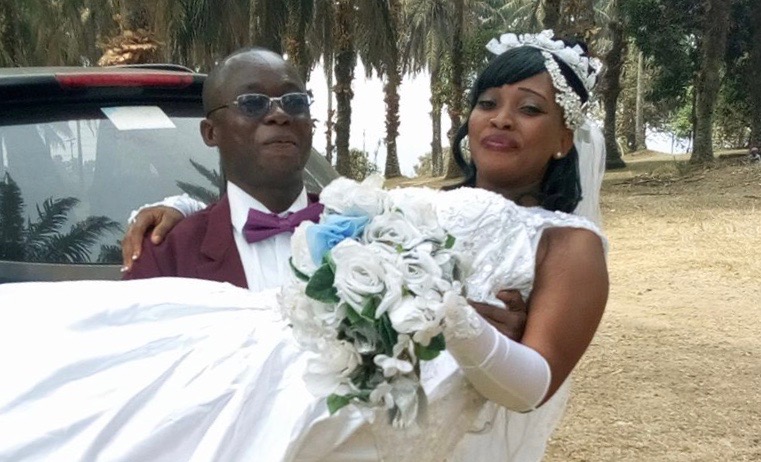
This week we experienced our first traditional wedding. Sidie Pumogie and Monjama Keifala were wed on Saturday in a traditional wedding, and then after church on Sunday, in a brief ceremony, their branch president married them in a “white man’s wedding”. The reception and party were held Saturday night after the traditional ceremony. Their’s is a wonderful love story. Sidie recently returned from a mission to Nigeria and Monjama waited for him to return. Their marriage is the culmination of many years of hard work, hope and faith. They will be sealed in the Accra, Ghana Temple the first week in February.
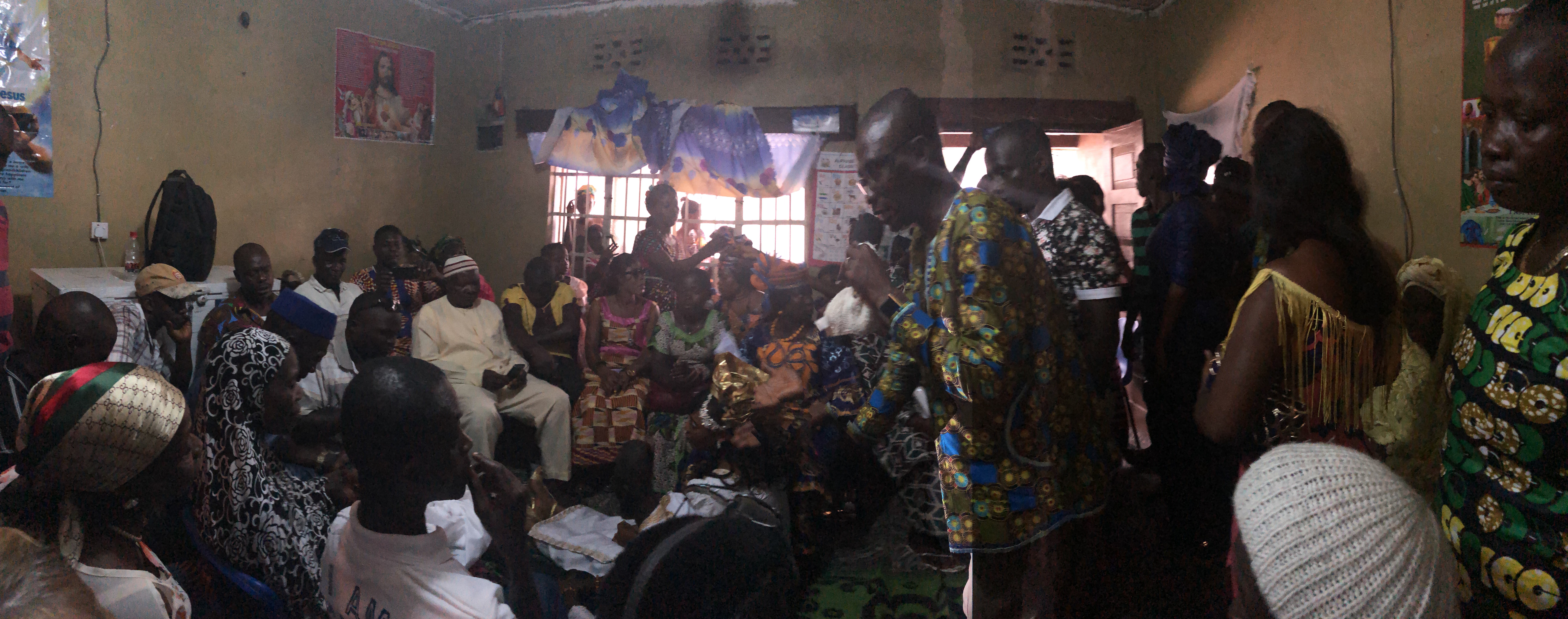
On Saturday afternoon, we arrived at the venue at 2:50 pm, because, well, we were told it would start at 3 pm. As it turns out the ceremony got underway about 4:30 pm. It lasted about 2 hours. Monjama was essentially raised by her aunt, who is married to President Braima, the first counselor in the district presidency. It was there at the Braima’s home that the marriage was solemnized. There were between 30-40 people in the living room which was probably about 12’ X 12’ in dimensions. The weather was mild outside, but inside with all of the people the temperature rose quickly.
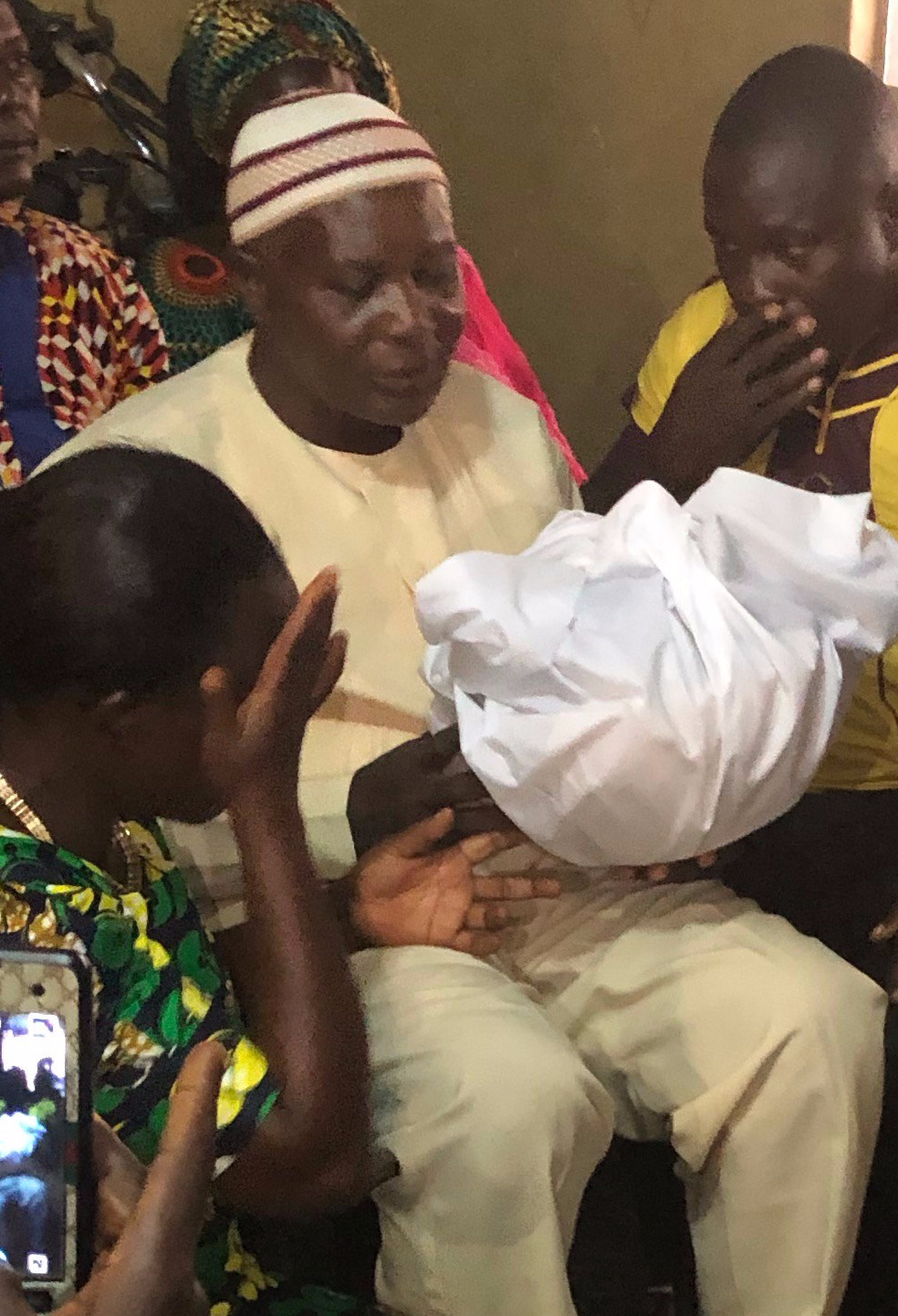
Much of the ceremony was in Mende so we didn’t understand all of it, but it was obvious that there was a problem with Monjama’s grandfather who didn’t agree with the marriage because he said he did not know the young man marrying his granddaughter. President Cobinah had just arrived and he asked if he could speak. He brought Sidie into the room and had him go around and greet all of the bride’s family and he spoke of the importance of unity and family. We couldn’t understand what the grandfather was saying and it seemed there were still a few rough spots in the ceremony because of his concerns, but somehow it all got worked out.
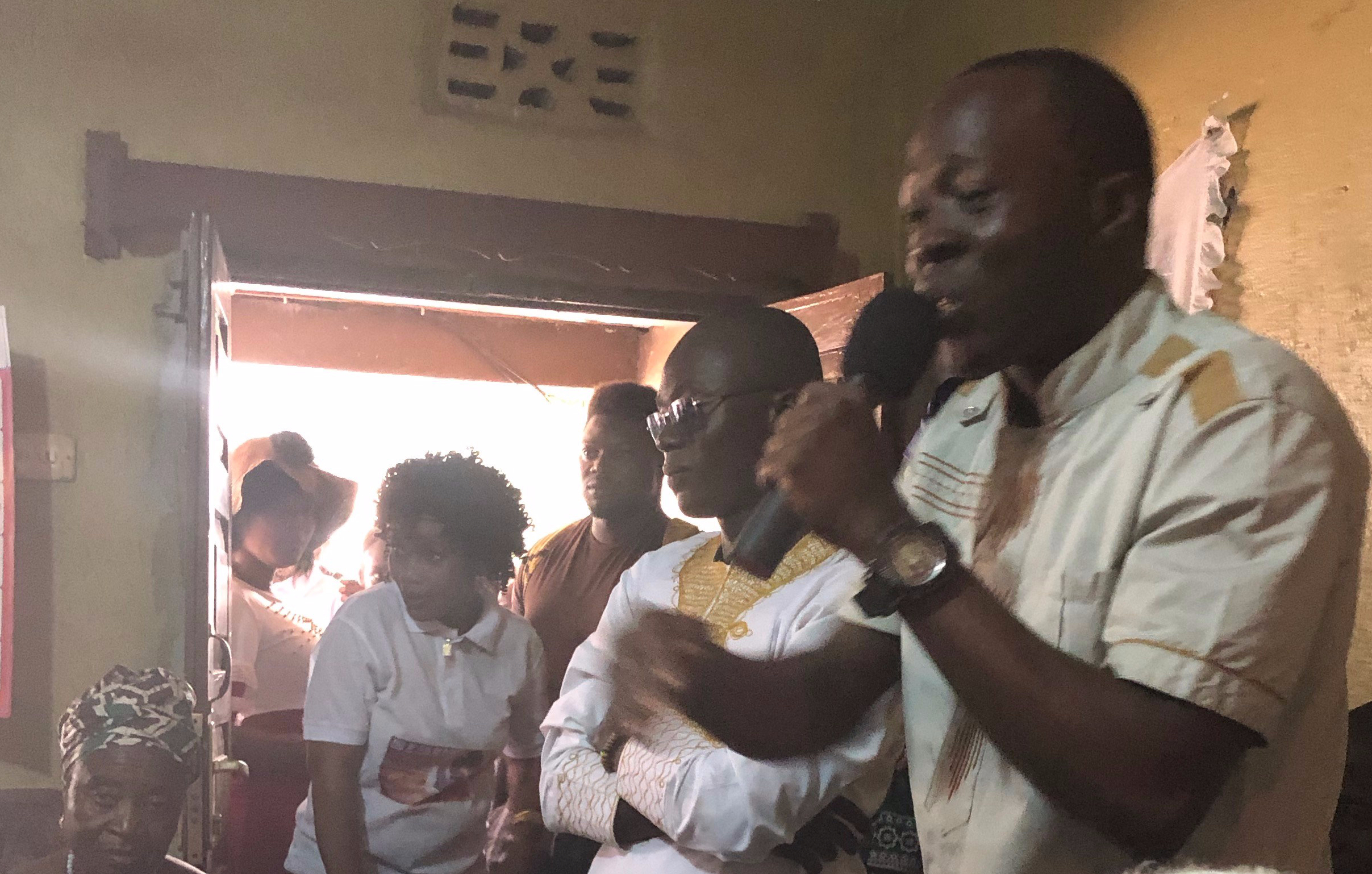
We were later told that this is not unusual. Often a member of the family will oppose the marriage in an expectation of the having the groom give money to the family to settle the concern. Whether that was the case here or not, we don’t know. There was no additional money passed to him so it perhaps his concerns were genuine. Somehow he finally got on board and the marriage was agreed and finalized, but it was tense there for a bit.
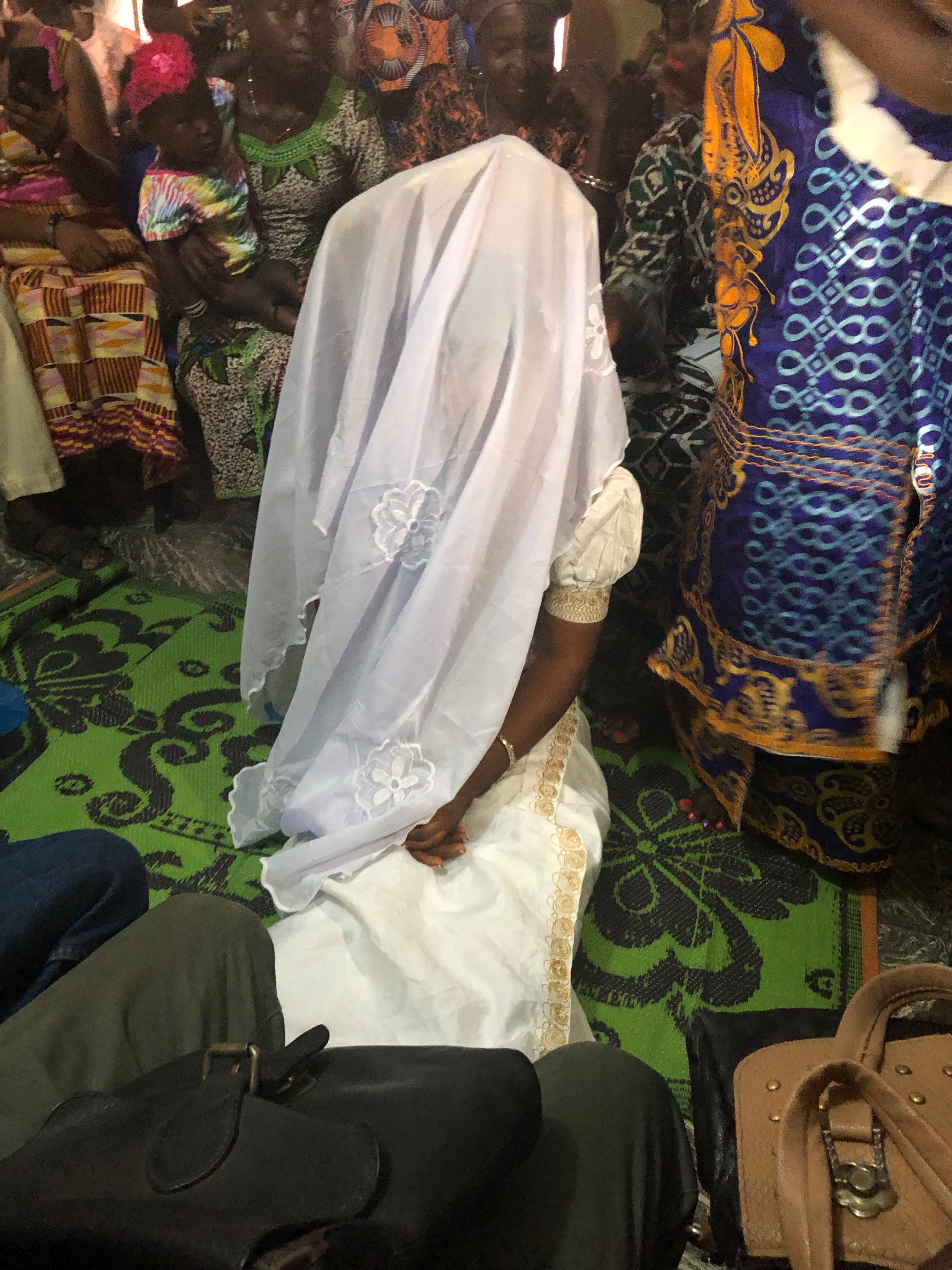
When Monjama came into the room she wore a beautiful white dress with an opaque white veil. The tradition is that guests give money to the woman bringing the bride into the room to “encourage” her to remove the veil so the crowd can see the bride’s face. When “enough” money was gifted the woman uncovered Monjama’s face. She was beautiful, but it was obvious she was feeling the stress of waiting so long to come out, hearing all of the bartering back and forth. It must have been difficult experiencing all of that. Once Monjama sat down, Sidie came in and sat down next to her.
I did some research on the internet and the best description resembling what we experienced came from a website called www.culturalweddingtraditions.weebly.com Here is a quote from the site: “The husband-to-be’s family comes to marry the bride with a delegation of family members and friends. This delegation includes a little girl of about 10 years of age who will be carrying a bottle gourd known as a calabash tied with a white cloth on her head. The little girl signifies purity in the marriage. This calabash will contain the bride price, needle and thread, kola nuts, a bible and different envelopes filled with money addressed to different family members. Each item has its significance. The bride price is the money the groom has paid to the bride’s family for her hand in marriage. This is considered a show of respect to the bride’s family. The needle and thread signifies that in times of difficulty the husband and wife will patch up their differences and work together. When you start to chew the kola nuts, it is very bitter in your mouth but once all that bitterness has gone away, it leaves a sweet taste in your mouth. There will be bitterness in your marriage sometimes, but in the end, sweetness (love) prevails. The bible is to allow God into your home. The different envelopes filled with money addressed to different family members signify oneness in both families. Each envelope will contain money for sisters, brothers, friends, neighbors, aunts and uncles who helped in bringing up the bride.”

There was no little girl with a calabash tied with a white cloth, but there was a calabash. We did not see a needle and thread, and the envelopes for the family members were not in the calabash itself, but rather handed out prior to the opening of the cloth. The kola nuts were important. A family member cracked one open and gave a piece of the center to each the bride and the groom. The bride fed a bite of hers to the groom and vice-versa. We read in another place where the kola nut depicts healing in a marriage and that the bride and the groom are to help heal each other throughout their marriage. Everything else was as described, as best as we could tell.
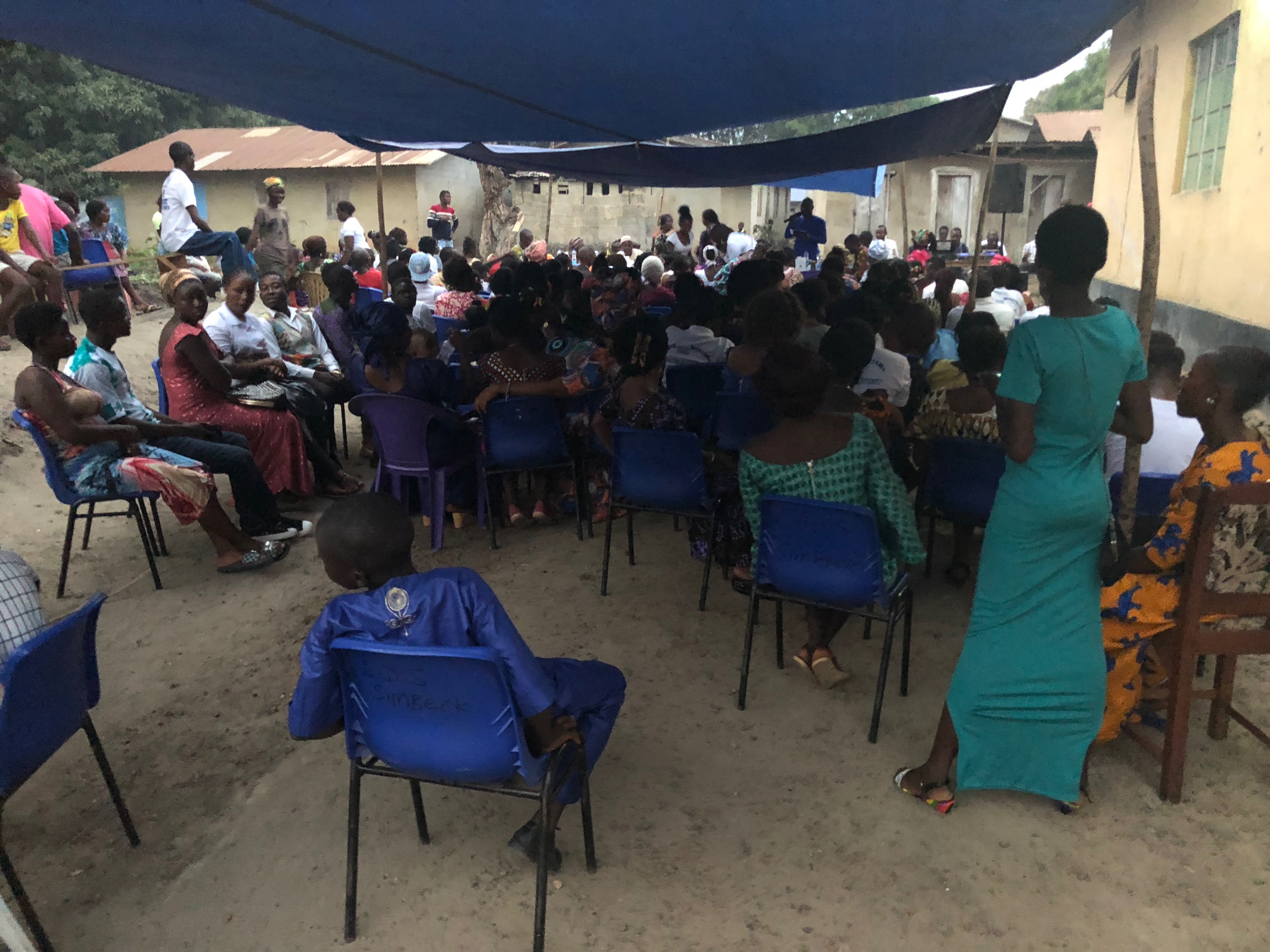
As Sidie and Monjama sat on the mat on the floor in front of the family elders, there were a lot of blessings pronounced upon the couple from various members of the family, mostly parents, grandparents, uncles and aunts. The section chief was present, which we understand is an important part of making the marriage legal and recognized by the government. After what must have seemed like an eternity to the bride and groom (it seemed so to us as well), the marriage was finalized (we could never tell exactly at what point this occurred) and the new couple left the room, followed by family and friends and a dinner and reception was held outside.

On Sunday, the families gathered together with some friends at the Simbeck chapel. President Cobinah had not been made aware of the Sunday wedding, and knowing that it was not a generally accepted practice to get married on a Sunday in the church, he asked that the official marriage be moved out of the chapel to the branch president’s office which is now outside of the main church building. Family again squeezed into the small room, President Martin Foday went through the brief ceremony of marriage as done in the church and then papers were signed in triplicate by the bride, the groom and five members on each side of the family.

This is the document that gets filed with the government, the church and the bride. Unfortunately, Monjama’s grandfather may have still been upset as he did not attend.
We have now experienced a traditional marriage to accompany our experience with a traditional burial. Interestingly enough, both occurred in the same branch! We have enjoyed experiencing these events in a culture very different from our own.
Weekly Highlights
With this week being New Years Eve and New Years Day, things were a bit slow, but started picking up towards the second half of the week. On New Years Day I went over and visited the family of one of our pre-mission boys. There was some question about how his mission was going to be funded and so I went over and spoke to his dad. The issue had to do with the money he had earned working to clean missionary apartments vs. the money he dad had committed to help pay for his mission. Fortunately, the question wasn’t about the money itself, that was not the issue, only who would be paying for what. It was quickly resolved. How I love being in the home of Latter-day Saints! Finding the street was a bit of a problem, but when I got close, I called the young man and he came to show me where they lived. As an aside, I tried to submit street names to Google Maps, but they indicated that they do not accept updates for this region of the world. I looked on Apple Maps and sure enough, not only do they accept updates, but many of Kenema’s streets are already named. They have already accepted 3 of the 8 church buildings which I submitted (now viewable on Apple Maps) and hopefully the other 5 will be approved soon. That will be a big help in the future for others who will come here.
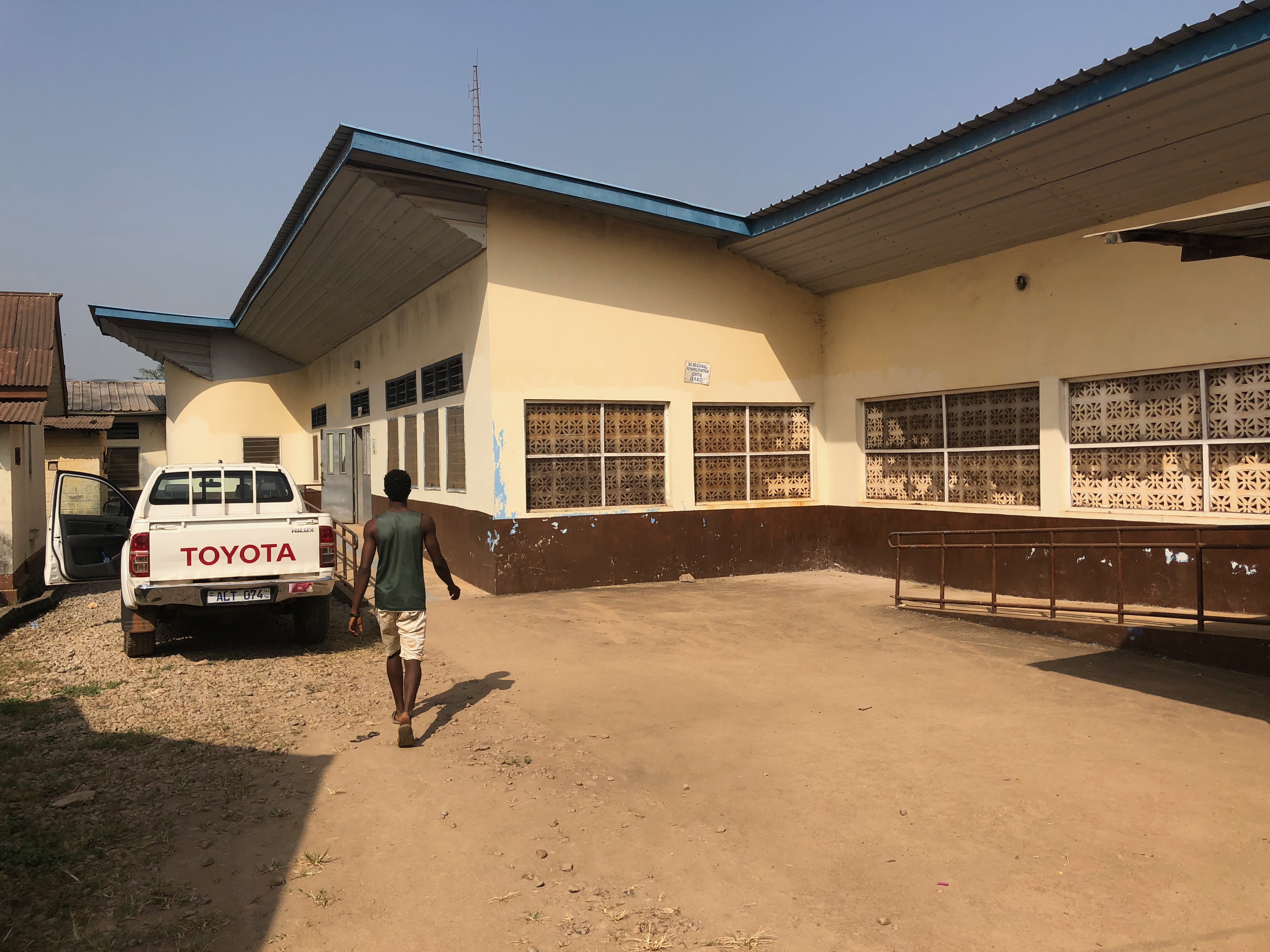
On Wednesday we made two trips to Bo. The first was to take the Zone Leaders to catch a ride to Freetown for the Mission Leaders Council. We left here right before 7 am and got them there right at 8:00 am. We then came immediately back to Kenema and picked up Josephine Amara, Ibrahim Williams (Dauda Town Elders Quorum President) and Mohammed Bockerie and headed back to Bo. Mohamed has his mission call and needed his patriarchal blessing. We got back to Bo about 10:00 am and dropped Mohamed off at the Bo West Stake Center where the Patriarch, Brother Berewa was to meet him between 9:00 – 9:30. We then took Josephine and Ibrahim over to the Government Hospital Rehabilitation Center where they were to assess and fit Josephine with a wheelchair sponsored by LDS Charities. Ibrahim had made all of the arrangements and wanted to come with her to make sure everything worked out okay. We dropped the two of them off at the hospital and ran a quick errand to the grocery stores to pick up a few things we cannot get easily in Kenema (or they are less expensive in Bo). By the time we were finished shopping Sister Amara was done. We went back over to pick them up, along with her new wheelchair. She was soooo happy!
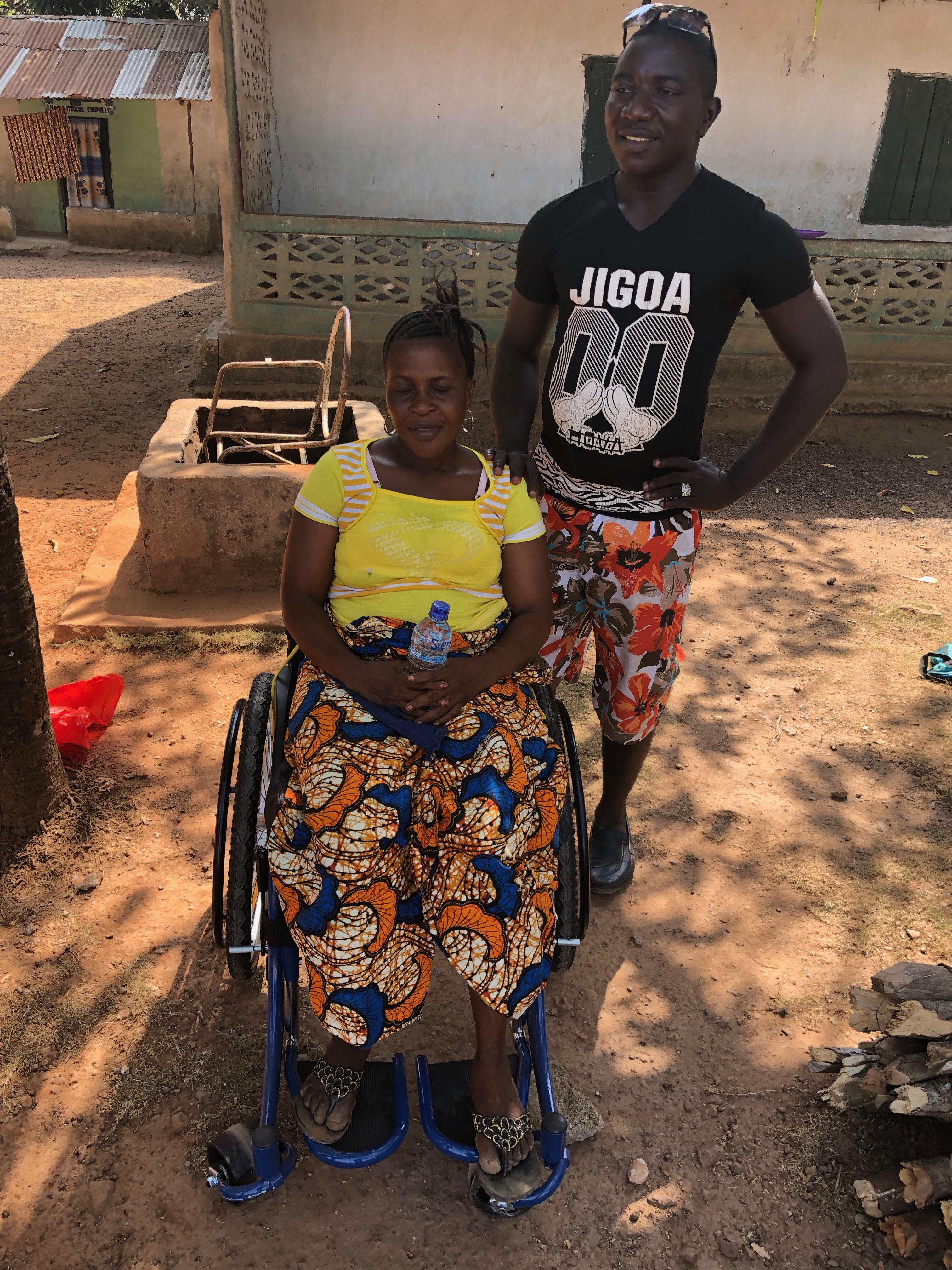
From there we drove back to the stake center, only to receive a call from the Patriarch as we got there saying Mohamed did not have a recommend. Turns out he thought all he needed was his temple recommend (which he has). So we scheduled another time to come back and left for home. As a side note, we found out getting a recommend for a patriarchal blessing was not so easy. Turns out only the clerk in his can see the option in the system to print out a form. Not even the branch president has the option available. It took us a few days, but we finally figured it out and Ibrahim Saffa, the Kpayama Branch clerk was able to get it printed for Mohamed.
On Thursday we attended the Kenema South District Council meeting where Elder McCracken is the District Leader. Sister Achi led a great discussion on receiving personal revelation and learning to hear the still small voice of the spirit. Elder McCracken then spoke about following the new standards of excellence. It was a wonderful meeting.
After lunch we went with Sidie Pumogie towards Bo, just past Bandama, where he purchased a number of bundles of wood for the reception. This was to build fires to cook the food for everyone who would come. It would have been difficult to get without a truck to throw it into and bring back and were grateful we could help in some small way. Before meeting Sidie to get the wood, we picked up keys we had made for the IDA apartment from the key maker. Unfortunately when we tried them later, neither one worked. I asked Charles (our guard) to take them back and have them rework them. We have the new set, but have not yet tried them. Even things which should be easy are often very difficult.
That evening (still Thursday) we had President Morison Nabieu and his wife (branch president in Kailahun) come to dinner. They have been staying with the Lima’s, so Sister Lima came also as her husband John was working until 8 pm. When we went to Kailahun, Sister Nabieu had made us a delicious meal and so we wanted to reciprocate. LaDawn fixed some delicious creamy coconut mushroom chicken. We also made some mashed potatoes. One of my new favorite meals for sure as the chicken just falls off the bones.
Friday was Tongo day. I took both the zone leaders (Adjety and Wallentine) and the IDA Elders (Hadlock and Makaafi) so they could teach people at different stages of progression at the same time. Friday we taught 17 people, meaning we picked up a couple of new investigators and had to bring them up to speed. There were 5 different groups or individuals taught on Friday making up the 17. If we were to count the other people listening it would be more like 25, but the 17 were earnestly engaged.
There were so many wonderful moments on Friday. Once again, Br. Solomon Kongoley was with us the entire time. Sister Messie was in Kenema so we missed her, but so appreciated the effort so many made to make themselves available to be taught. I love their sincere questions, their desire to know if what the missionaries are teaching and their childlike faith, willingly accepting the challenge to find out for themselves. In some cases the people cannot read or write (the exception and not the rule), yet their humility and faith is inspiring. They feel the truth of the doctrines deep in their soul, even though they do not fully understand the depth and the breadth of the gospel message. I have included a picture of the inside of the old “Winners” chapel. This is the building we are in negotiations for renting as it would be an ideal location and size for the branch. We will see what happens.
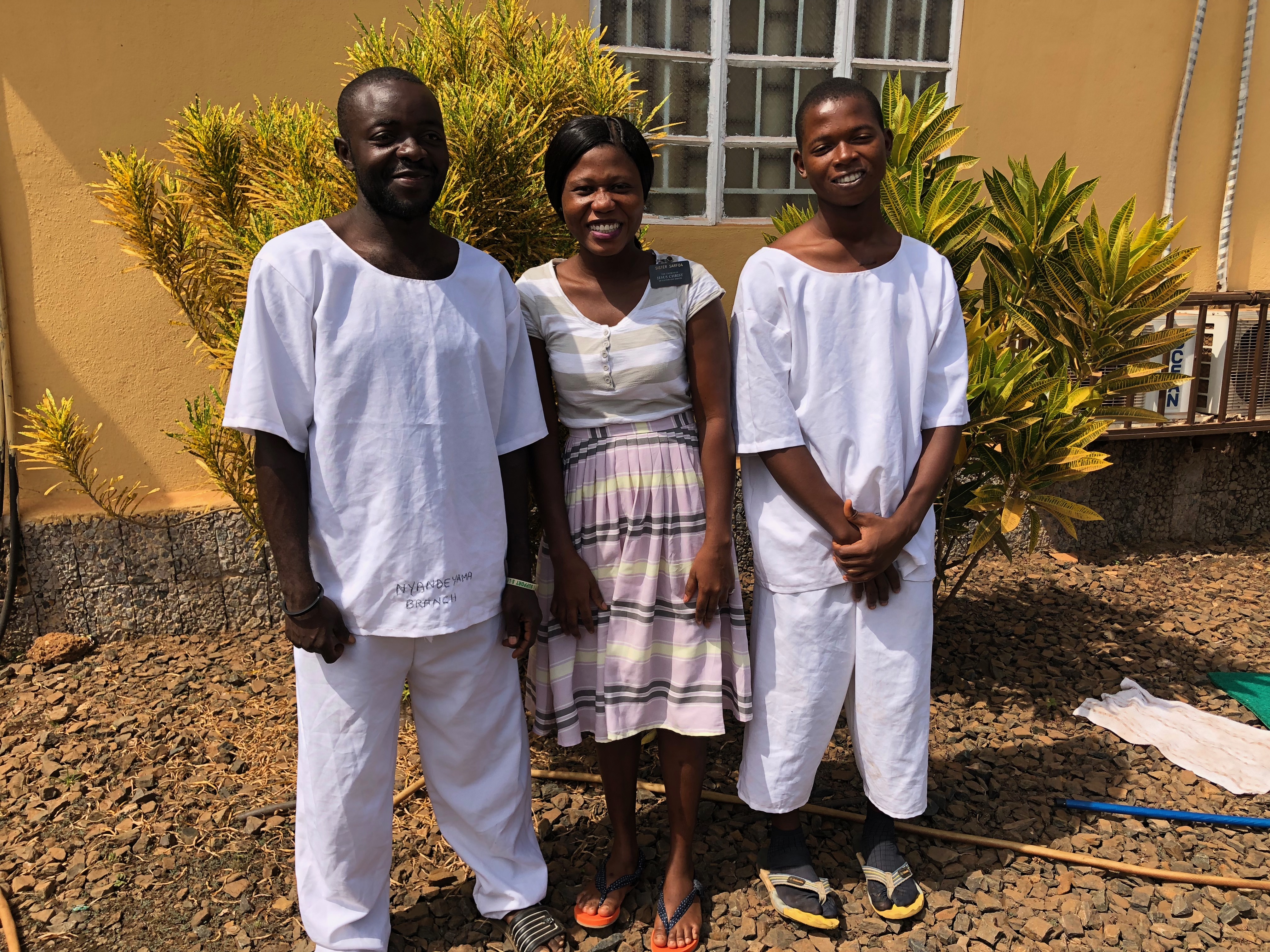
Saturday was national cleaning day so no one can venture out until after noon. We attended the baptism of Memoh Bockerie Amara in the afternoon. It was a Simbeck Branch baptism, but seems that Nyandeyama is one of the few fonts working and so it was held next door. That was good for us. We are always privileged to be a part of seeing new members come into the church, filled with faith and hope and a desire to please God. He was baptized by James Bunduka, the young man who washes our truck each week. Sister Sarfoa is working with branch missionaries this transfer as we are a sister short in the mission. She is actually in a trio with Sister Achi and Sister Kisangala, but during the day proselytes with a young woman from Simbeck.
We already talked about the wedding which is where we went after the baptism. We ended the day by helping the branch haul all of the chairs back to the chapel from the reception. It only took about an hour and was so much easier than trying to do it with motorbikes!
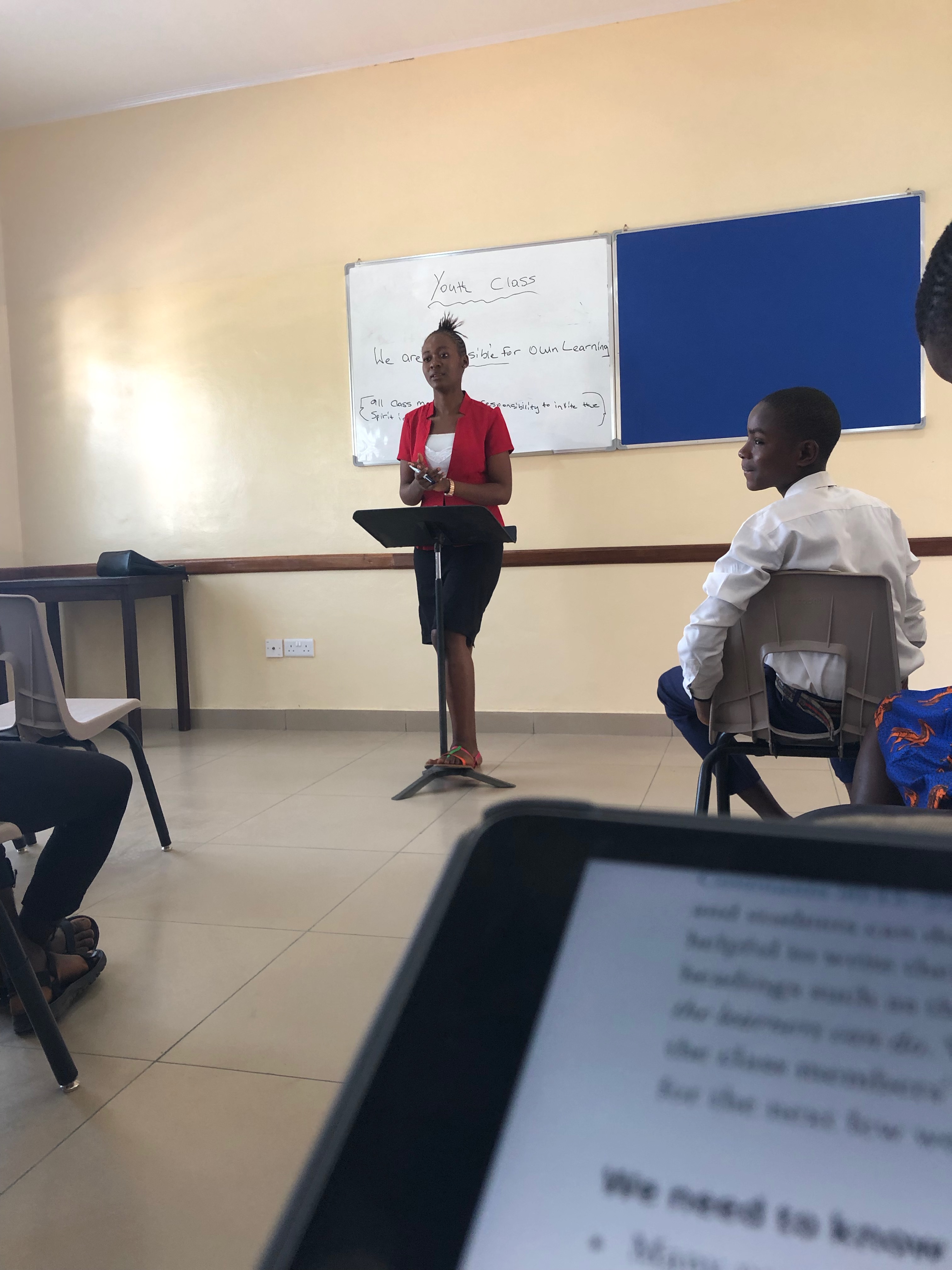
On Sunday we attended the IDA branch. We had a wonderful testimony meeting that went a little long, but it was good from beginning to end. I attended the youth Sunday school class and LaDawn split her time between Primary and the Gospel Doctrine class. The youth class was taught by Mariama Gendemeh. This is the same young woman that taught the family history class last time we were there. She an outstanding teacher. She began teaching lesson 2 instead of lesson 1, but she quickly adjusted and did a marvelous job without even studying the lesson. She had good interactions with the youth and encouraged discussion. I was thinking about how good she would be if she had a week to prepare! She is only 18 years old but so much wiser and polished than many twice her age!
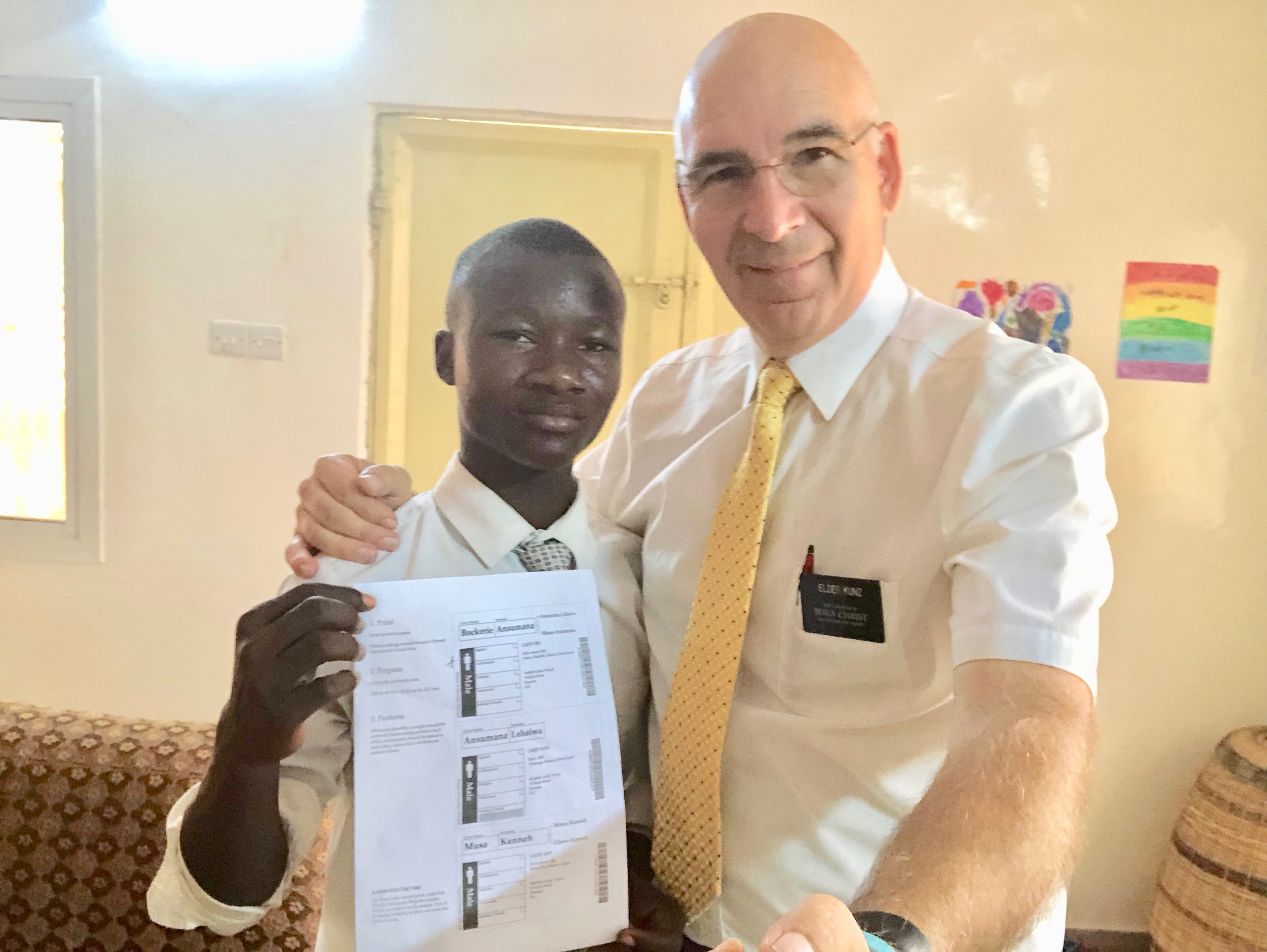
After church we went over to the Simbeck Branch and witnessed the brief church wedding for Sidie and Monjama and then came home. We brought Ibrahim Yorpoi home with us because he had a question about his LDS.org account. We were able to resolve the issue rather quickly and connected him to our internet and then he sat on our sofa for a couple of hours looking through LDS.org. We love this young man. He is valiant in all aspects of the word. Plus having him back over gave me an opportunity to snap a picture with him showing one of the pages of temple names he has prepared.
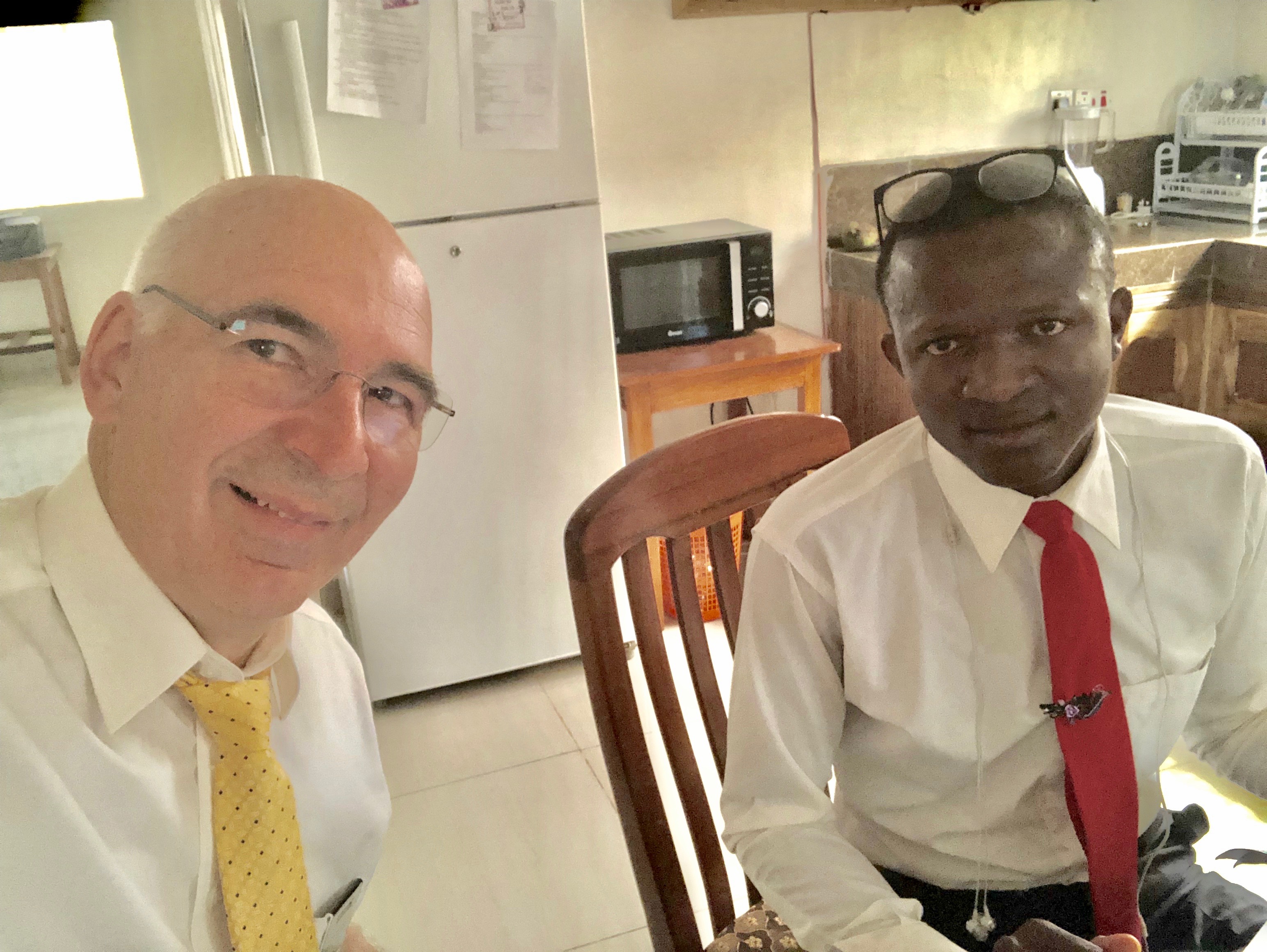
President Lamina had called right when we got home and asked if Solomon Amara could come over to load his mission papers into the system. At 1:30 he showed up as agreed and we worked for the next 2 hours to get him setup with an LDS.org account, a new gmail account and get all of his papers into the system. We only need his school certificate and his yellow fever card and he will be one more young man with his missionary papers submitted. Clinton Gaima came with him so he could pick up the blood tonic and vitamins that we purchased to help him get his hemoglobin count up so he can get his papers submitted as well. As we have mentioned before, we love working with these young men and young women as they prepare for their missions. This is such an important part of Kenema’s future as many of these young men and young women will form the nucleus of future leadership here.
Traditions can either be a blessing or a stumbling block, or in some cases a little of both. Some of the traditions here, such as mentioned in the post on Secret Societies, can slow down the progress, and even be a stumbling block for fully accepting and living the gospel of Jesus Christ. On the other hand, some traditions are positive and can strengthen family bonds. Here in Sierra Leone, the traditional marriage has many aspects that are wonderful. Bringing families together and getting everyone on the same page can be a great blessing to the newlyweds. However, the concept of a “bride price” is still a stumbling block for many and is counter to the culture of the Church of Jesus Christ. We believe with time, as multigenerational families begin to take root in this country, these older traditions that tend to limit marriage will fade and new ones filled with hope, love and gospel understanding and learning will emerge .
What an amazing experience!
LikeLike
Thank you for sharing your experiences! Laura and I have had our testimonies strengthened by the great work being done in Kenema and surrounding areas. Your words have helped us understand the work being done and is helping us prepare for our service in Sierra Leone. How grateful we feel knowing there will be those with experience helping us adjust. We look forward to serving with you among these great saints.
LikeLike
President Harper, we are thrilled to have you come to Sierra Leone and look forward to meeting you and your wonderful wife. Being engaged in this work continues to bring us great joy and we are happy we will have a chance to work closely with you. Hurrah for Israel!
LikeLike
Pingback: Paederus sabaeus Erichson | Kunz Corner